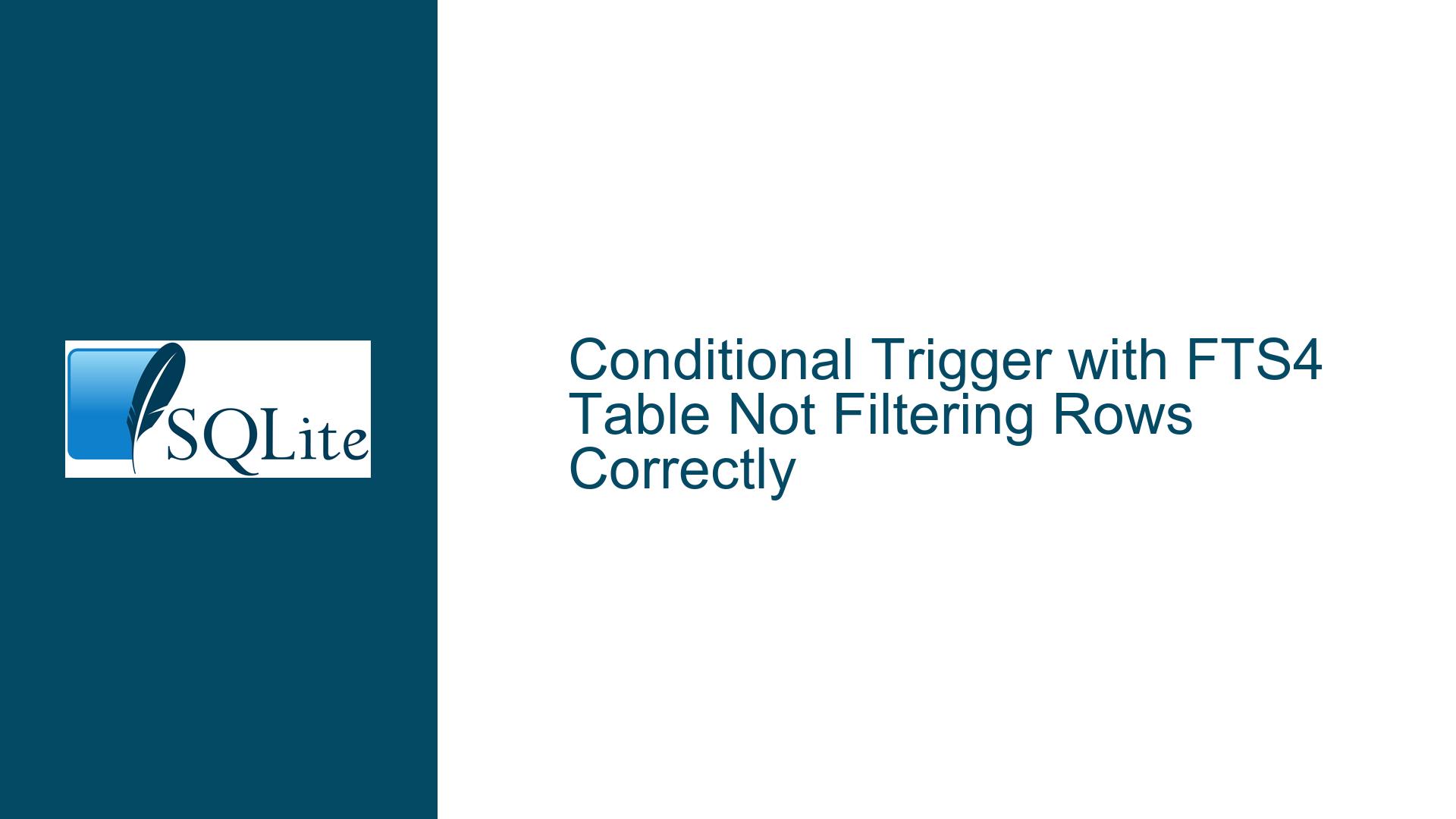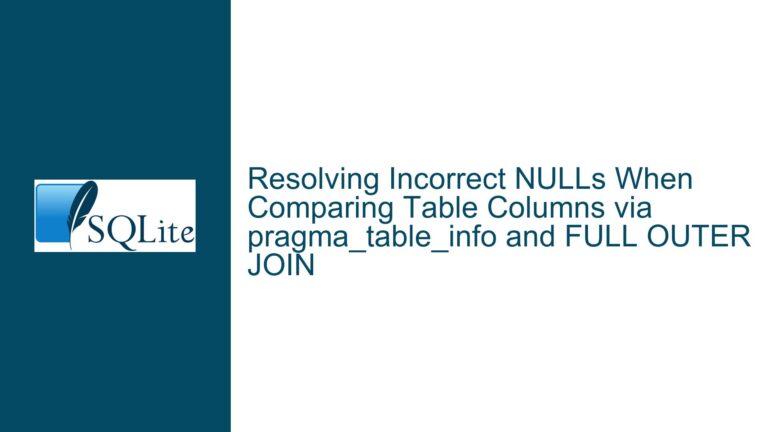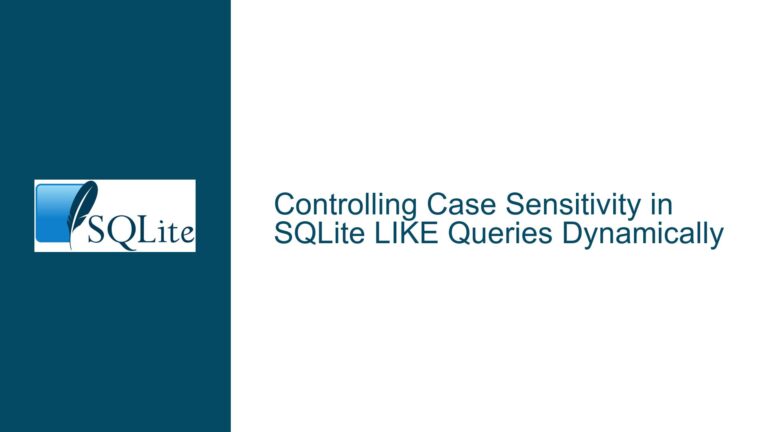Conditional Trigger with FTS4 Table Not Filtering Rows Correctly
Issue Overview: Conditional Trigger on FTS4 Table Ignoring WHEN Clause
When working with SQLite, particularly with Full-Text Search (FTS) tables, developers often encounter scenarios where conditional triggers do not behave as expected. In this case, the issue revolves around a trigger designed to insert rows into an FTS4 table (BDFTS) only when a specific condition is met (NEW.A > 1). However, the trigger appears to ignore the WHEN clause, resulting in all rows from the base table (BD) being inserted into the FTS4 table, regardless of the condition.
The core of the problem lies in the interaction between the FTS4 table’s external content mechanism and the trigger’s conditional logic. The FTS4 table, configured with the CONTENT option, is designed to pull data from the base table (BD) directly when queried. This behavior can obscure the intended filtering logic of the trigger, making it seem as though the WHEN clause is being ignored.
To fully understand the issue, it is essential to break down the components involved:
- Base Table (
BD): A standard SQLite table with columnsA(integer) andB(text). - FTS4 Table (
BDFTS): A virtual table configured for full-text search, using theCONTENToption to reference the base table (BD). - Trigger (
BDFTSI): AnAFTER INSERTtrigger on the base table (BD) with aWHENclause (NEW.A > 1) designed to conditionally insert rows into the FTS4 table (BDFTS).
The expectation is that only rows from BD where A > 1 should be inserted into BDFTS. However, querying BDFTS returns all rows from BD, leading to confusion about the trigger’s functionality.
Possible Causes: Misunderstanding FTS4 External Content Behavior
The primary cause of this issue stems from a misunderstanding of how FTS4 tables with the CONTENT option interact with their base tables. The CONTENT option in FTS4 tables allows the virtual table to reference an external table (in this case, BD) for its data. This means that when you query the FTS4 table (BDFTS), SQLite retrieves the data directly from the base table (BD), bypassing the trigger’s conditional logic.
Here are the key points that contribute to this behavior:
- External Content Mechanism: The
CONTENToption in FTS4 tables is designed to synchronize the FTS4 table with the base table. When you queryBDFTS, SQLite reads the data fromBDinstead of the FTS4 index. This synchronization mechanism overrides the trigger’s conditional insertion logic. - Trigger Execution: The trigger (
BDFTSI) does execute as expected, inserting rows intoBDFTSonly whenNEW.A > 1. However, these insertions are effectively overwritten by the external content mechanism when queryingBDFTS. - Query Behavior: When you run a
SELECT * FROM BDFTS, SQLite retrieves the data fromBDdirectly, ignoring the rows that were conditionally inserted intoBDFTSby the trigger. This makes it appear as though theWHENclause in the trigger is not functioning.
Additionally, the version of SQLite being used (3.24.0) may have specific behaviors or limitations related to FTS4 tables and triggers. While the issue is not directly related to the SQLite version, it is always good practice to ensure that you are using the latest stable version to avoid any known bugs or limitations.
Troubleshooting Steps, Solutions & Fixes: Addressing FTS4 External Content and Trigger Behavior
To resolve the issue of the conditional trigger not filtering rows correctly in an FTS4 table, you need to understand and address the interaction between the FTS4 table’s external content mechanism and the trigger’s conditional logic. Below are detailed steps and solutions to troubleshoot and fix the problem:
1. Understanding FTS4 External Content Behavior
- Explanation: The
CONTENToption in FTS4 tables is designed to keep the FTS4 table synchronized with the base table. When you query the FTS4 table, SQLite retrieves the data from the base table directly, bypassing any conditional logic applied by triggers. - Implication: This means that even if the trigger successfully inserts only the desired rows into the FTS4 table, querying the FTS4 table will still return all rows from the base table, making the trigger’s conditional logic seem ineffective.
2. Verifying Trigger Execution
- Step: To verify that the trigger is executing correctly, you can temporarily modify the trigger to insert rows into a standard table instead of the FTS4 table.
- Example:
CREATE TABLE BD (A integer, B TEXT); CREATE TABLE BDFTS_TEST (DOCID integer, A integer, B TEXT); CREATE TRIGGER BDFTSI AFTER INSERT ON BD WHEN NEW.A > 1 BEGIN INSERT INTO BDFTS_TEST(DOCID, A, B) VALUES (NEW.ROWID, NEW.A, NEW.B); END; INSERT INTO BD VALUES(1, '000'); INSERT INTO BD VALUES(1, '111'); INSERT INTO BD VALUES(2, '222'); INSERT INTO BD VALUES(3, '333'); SELECT * FROM BDFTS_TEST; - Expected Result: The
BDFTS_TESTtable should contain only the rows whereA > 1(i.e.,(2, '222')and(3, '333')). This confirms that the trigger’sWHENclause is functioning correctly.
3. Reconfiguring the FTS4 Table Without External Content
- Step: If the trigger’s conditional logic is essential, consider reconfiguring the FTS4 table without the
CONTENToption. This means that the FTS4 table will maintain its own data independently of the base table. - Example:
CREATE TABLE BD (A integer, B TEXT); CREATE VIRTUAL TABLE BDFTS USING FTS4 (A, B); CREATE TRIGGER BDFTSI AFTER INSERT ON BD WHEN NEW.A > 1 BEGIN INSERT INTO BDFTS(DOCID, A, B) VALUES (NEW.ROWID, NEW.A, NEW.B); END; INSERT INTO BD VALUES(1, '000'); INSERT INTO BD VALUES(1, '111'); INSERT INTO BD VALUES(2, '222'); INSERT INTO BD VALUES(3, '333'); SELECT * FROM BDFTS; - Expected Result: The
BDFTStable should contain only the rows whereA > 1(i.e.,(2, '222')and(3, '333')). This approach ensures that the FTS4 table reflects the trigger’s conditional logic.
4. Using Full-Text Queries to Validate Trigger Behavior
- Step: If you must use the
CONTENToption, you can validate the trigger’s behavior by running full-text queries against the FTS4 table. The full-text index will only contain the rows inserted by the trigger, even though the base table contains all rows. - Example:
CREATE TABLE BD (A integer, B TEXT); CREATE VIRTUAL TABLE BDFTS USING FTS4 (CONTENT="BD", A, B); CREATE TRIGGER BDFTSI AFTER INSERT ON BD WHEN NEW.A > 1 BEGIN INSERT INTO BDFTS(DOCID, A, B) VALUES (NEW.ROWID, NEW.A, NEW.B); END; INSERT INTO BD VALUES(1, '000'); INSERT INTO BD VALUES(1, '111'); INSERT INTO BD VALUES(2, '222'); INSERT INTO BD VALUES(3, '333'); -- Full-text query to validate trigger behavior SELECT * FROM BDFTS WHERE BDFTS MATCH '222'; SELECT * FROM BDFTS WHERE BDFTS MATCH '333'; - Expected Result: The full-text queries should return only the rows where
A > 1(i.e.,(2, '222')and(3, '333')). This demonstrates that the trigger’s conditional logic is correctly applied to the full-text index.
5. Alternative Approach: Manual Synchronization
- Step: If reconfiguring the FTS4 table is not feasible, consider manually synchronizing the FTS4 table with the base table using a combination of triggers and manual updates.
- Example:
CREATE TABLE BD (A integer, B TEXT); CREATE VIRTUAL TABLE BDFTS USING FTS4 (CONTENT="BD", A, B); -- Trigger to insert rows into FTS4 table CREATE TRIGGER BDFTSI AFTER INSERT ON BD WHEN NEW.A > 1 BEGIN INSERT INTO BDFTS(DOCID, A, B) VALUES (NEW.ROWID, NEW.A, NEW.B); END; -- Trigger to delete rows from FTS4 table CREATE TRIGGER BDFTSD AFTER DELETE ON BD WHEN OLD.A > 1 BEGIN DELETE FROM BDFTS WHERE DOCID = OLD.ROWID; END; -- Trigger to update rows in FTS4 table CREATE TRIGGER BDFTSU AFTER UPDATE ON BD WHEN NEW.A > 1 BEGIN UPDATE BDFTS SET A = NEW.A, B = NEW.B WHERE DOCID = NEW.ROWID; END; INSERT INTO BD VALUES(1, '000'); INSERT INTO BD VALUES(1, '111'); INSERT INTO BD VALUES(2, '222'); INSERT INTO BD VALUES(3, '333'); -- Manual synchronization if needed DELETE FROM BDFTS WHERE DOCID IN (SELECT ROWID FROM BD WHERE A <= 1); - Expected Result: The FTS4 table (
BDFTS) should remain synchronized with the base table (BD) while respecting the conditional logic (A > 1). This approach requires careful management of insertions, deletions, and updates to ensure data consistency.
6. Upgrading SQLite Version
- Step: Ensure that you are using the latest stable version of SQLite. While the issue is not directly related to the SQLite version, upgrading can help avoid any known bugs or limitations related to FTS4 tables and triggers.
- Action: Download and install the latest version of SQLite from the official website (https://sqlite.org/download.html).
7. Testing and Validation
- Step: After implementing any of the above solutions, thoroughly test the behavior of the FTS4 table and the trigger to ensure that the conditional logic is correctly applied.
- Action: Run a series of insertions, updates, and deletions on the base table (
BD) and verify that the FTS4 table (BDFTS) reflects the expected results. Use both standard queries and full-text queries to validate the data.
By following these troubleshooting steps and solutions, you can effectively address the issue of conditional triggers not filtering rows correctly in an FTS4 table. Understanding the nuances of FTS4’s external content mechanism and adjusting your schema and triggers accordingly will ensure that your database behaves as expected.






